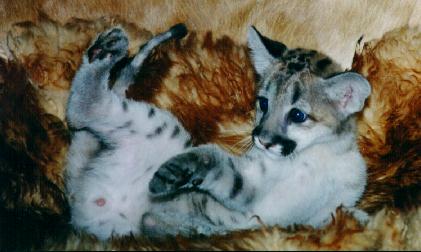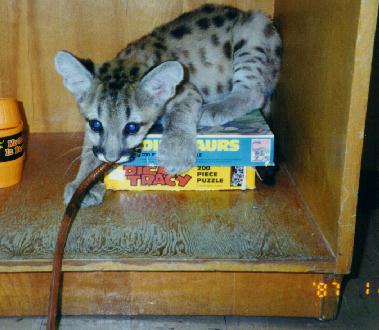Cougar,
Puma, Mountain Lion
What a hunka hunka! - and the cat ain't bad either. Sam and
Dakota - Buds!
Cougars are also called Mountain Lion,
Puma and Panther as well as other names. This cat (Felis concolor)
is the largest member of the genus 'Felis". They are found in both North
and South America from northern Canada to Chile. This highly adaptable cat
also has a broad range in elevation from sea level to 14,000 feet!!! They
are from 40" to 80" long, with a tail about 2/3 the length of the body.
Weight can range from 80 to 250 lb. with the males being the larger of the
two sexes. They stand about 24 to 28 inches at the shoulder. The smaller
sizes are usually found in the warmer climates while the larger sizes are
in colder areas.
Here is a cute limerick I found on a chat list: Sorry, I do not know the
author. If you do, let me know and I will include it.
There once was a man from Yuma--
Played a practical joke on a puma.
Now his bleached bones lie bland--
On the hot desert sand.
The puma had no sense of huma.
This incredibly powerful cat has great
strength for leaping, jumping and climbing. It is a good swimmer as well.
Their most powerful sense is that of sight with hearing running a close
second. They hunt at anytime of the day or night depending on the location
and pattern of the prey in their area.
They eat small animals such as rabbits, beaver, as well as large prey such
as deer, elk, etc. They breed all year long with most births during the
spring and summer when game is most plentiful. Litters range from 2 to 5,
averaging four. Gestation is 90 to 96 days. The cubs nurse for about 12
weeks and may remain with their mother for up to a year. Sexual maturity
is from 2 to 3 years of age. Cubs are born blue-eyed and spotted and remain
spotted until 6 to 12 months of age.
Apache (10 week-old cub) lounges on the couch.
Cougars in captivity are not to be taken
lightly. They are powerful and smart which is evidenced by their survival
capabilities in the wild. They need an environment large enough that will
permit exercise of their muscles and enriched to keep their minds active
and healthy.
Although they can easily be taught at a young age to walk on a leash, their
sheer power does not make this a safe practice unless it is done in an escape-proof
enclosure.
Jumping shelves of varying graduated heights and tree stumps or heavy branches
are welcome.
Declawing is suggested at an early age for animals that will have lots of
human interaction.
Cougars are very playful and can be extremely destructive to toys and playthings.
Some cougars will eat plastic, fabric, rubber, etc. so careful watch must
be maintained of their objects. Change objects frequently to they will not
tire. Plastic milk jugs with the lids removed make fun toys and can be changed
every 2 to 3 days before 'eating' behavior begins. Small garden tractor
tires suspended by a chain are also a fun toy. However some cougars have
a habit of eating what ever they can get their teeth into and tear up. This
is called 'pica'. They can even chew these tires and swallow bits and pieces
and become impacted in their intestines. Watch all toys and other objects
in their environment to see that small pieces have not been chewed off.
If they have been and you cannot find them, remove the objects and check
the feces daily to see of the objects have passed through the system.
If not, you may need to consult your veterinarian for radiographs, laxatives
or SURGERY!
Spots begin to disappear about weaning time but can still
be there at 9 mos.
Cougars can be litter-trained
and a small child's wading pool or better yet, a less fragile 'disposable
mortar box' that can be purchased at building supply stores are great.
Feeding can include all raw food, all processed food or a mixture of both.
Purina Mazuri Feline Diet mixed with ground chicken (either raw or cooked)
bones and all plus added zoological vitamins will give your cat a nice
glow. We suggest adding a handful of fresh grass (that has had no fertilizer,
pesticides, fungicides, residue from cars, lawnmowers, etc.) every other
day to their enclosure. This aids in digestion and helps the cat to 'barf'
up hairballs that form in the digestive system from grooming.
R-Zu-2-U Home
R-Zu-2-U FAQs
R-Zu-2-U Animal "Terms"
Treasure Ranch Home



